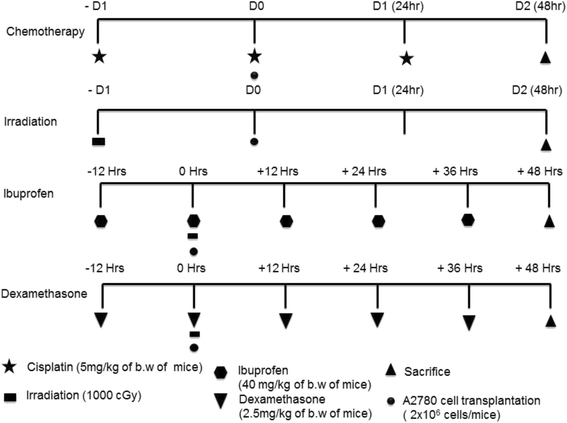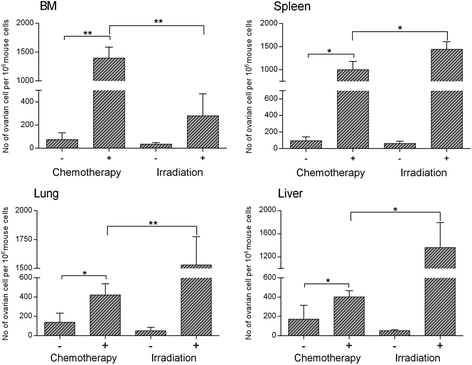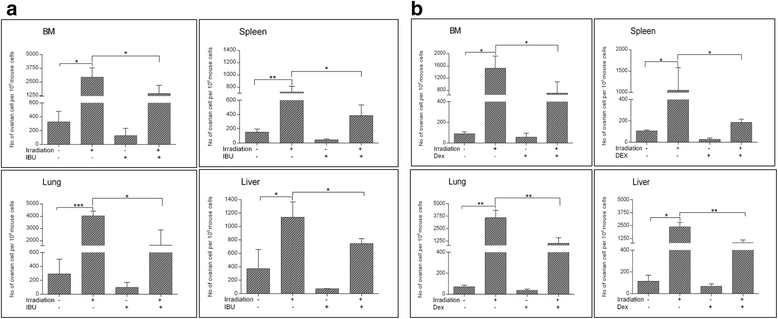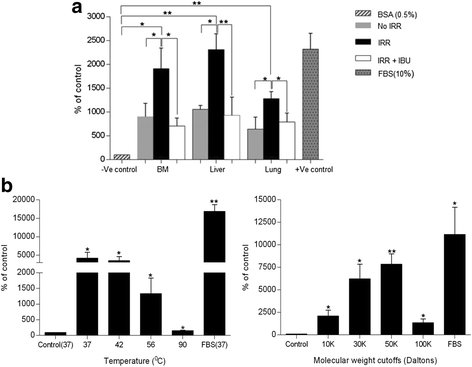Evidence for induction of a tumor metastasis-receptive microenvironment for ovarian cancer cells in bone marrow and other organs as an unwanted and underestimated side effect of chemotherapy/radiotherapy
- PMID: 25887079
- PMCID: PMC4425926
- DOI: 10.1186/s13048-015-0141-7
Evidence for induction of a tumor metastasis-receptive microenvironment for ovarian cancer cells in bone marrow and other organs as an unwanted and underestimated side effect of chemotherapy/radiotherapy
Abstract
Background: One of side effects of chemotherapy and radiotherapy is the induction of several factors in various tissues and organs that create a pro-metastatic microenvironment for cancer cells that survive initial treatment.
Methods: In the present study, we employed human ovarian cancer cell line A2780 and immunodeficient mice xenograft model to test effect of both ibuprofen and dexamethasone to ameliorate the therapy-induced pro-metastatic microenvironment in bone marrow, liver, and lung.
Results: In our studies, we found that total body irradiation or administration of cisplatin increases the metastatic spread of human ovarian cancer cells transplanted into immunodeficient mice compared with animals unexposed to irradiation or cisplatin. Moreover, conditioned media harvested from irradiated murine bone marrow, lung, and liver chemoattracted human ovarian cancer cells, and this chemotactic activity was inactivated by heat, suggesting a major involvement of peptide or peptide-bound chemoattractants. We also observed that human ovarian cancer cells proliferate better if exposed to cell debris harvested from irradiated murine bone marrow. Finally, the pro-metastatic microenvironment in mice induced by radio- or chemotherapy was significantly ameliorated if animals were treated at the time of radiotherapy administration with non-steroid (ibuprofen) or steroid (prednisone) anti-inflammatory drugs.
Conclusions: In summary, we propose that a radiochemotherapy-induced, pro-metastatic microenvironment plays an important role in the metastasis of cancer cells that are resistant to treatment. Such cells have characteristics of cancer stem cells and are highly migratory, and simple, intensive, anti-inflammatory treatment by non-steroid agents to suppress induction of pro-metastatic factors after radiochemotherapy would be an interesting anti-metastatic treatment alternative.
Figures





References
-
- Kim CH, Wu W, Wysoczynski M, Abdel-Latif A, Sunkara M, Morris A, et al. Conditioning for hematopoietic transplantation activates the complement cascade and induces a proteolytic environment in bone marrow: a novel role for bioactive lipids and soluble C5b-C9 as homing factors. Leukemia. 2012;26:106–16. doi: 10.1038/leu.2011.185. - DOI - PMC - PubMed
-
- Jankowski K, Kucia M, Wysoczynski M, Reca R, Zhao D, Trzyna E, et al. Both hepatocyte growth factor (HGF) and stromal-derived factor-1 regulate the metastatic behavior of human rhabdomyosarcoma cells, but only HGF enhances their resistance to radiochemotherapy. Cancer Res. 2003;63:7926–35. - PubMed
-
- Ratajczak MZ, Kim CH, Abdel-Latif A, Schneider G, Kucia M, Morris AJ, et al. A novel perspective on stem cell homing and mobilization: review on bioactive lipids as potent chemoattractants and cationic peptides as underappreciated modulators of responsiveness to SDF-1 gradients. Leukemia. 2012;26:63–72. doi: 10.1038/leu.2011.242. - DOI - PMC - PubMed
Publication types
MeSH terms
Substances
Grants and funding
LinkOut - more resources
Full Text Sources
Other Literature Sources
Medical

